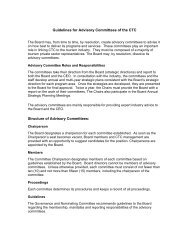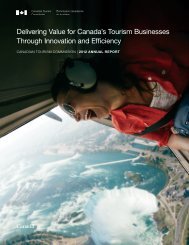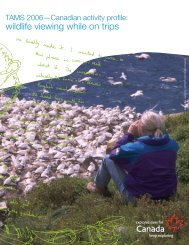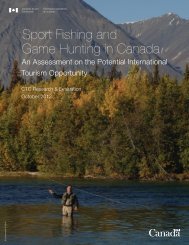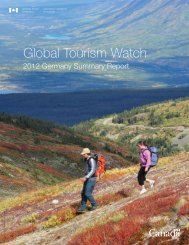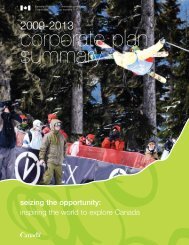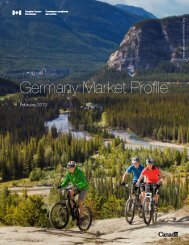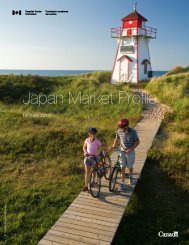Canadian Soft Outdoor Adventure Enthusiasts - Canadian Tourism ...
Canadian Soft Outdoor Adventure Enthusiasts - Canadian Tourism ...
Canadian Soft Outdoor Adventure Enthusiasts - Canadian Tourism ...
Create successful ePaper yourself
Turn your PDF publications into a flip-book with our unique Google optimized e-Paper software.
Percentage of Adult Population In . . . 2026 Proportion of <strong>Canadian</strong> adults in 2026 who are<br />
projected to fit the demographic characteristic (e.g., age, gender, place of birth) or participate in a<br />
particular activity (e.g., travel to a particular destination; golf, ski, camp or go to a museum while on<br />
trips). Example: 18 – 34 year olds are expected to represent 25 per cent of all <strong>Canadian</strong> adults, or<br />
7.3 million of the 29.6 million <strong>Canadian</strong> adults (2026).<br />
Growth Rate from 2000 to 2026 Anticipated rate of change in the number of <strong>Canadian</strong> adults who<br />
will fit the demographic or behavioural characteristic by 2026. Example: the 7.3 million 18 – 34<br />
year olds in 2026 is virtually identical to the 7.3 million 18 – 34 year olds in 2000.<br />
Impact of 2026 Population Structure on Growth Rate How much the structure of the population<br />
projected for 2026 will influence the growth rate of a demographic or behavioural characteristic.<br />
Negative numbers suggest a downward pressure on growth rates and positive numbers represent an<br />
upward pressure. Example: the growth rate for 18 – 34 year olds (0.47%) will be 98 per cent lower<br />
than it would have been if the structure of the population had remained as it is was in 2000. Thus, if<br />
the population structure of 2000 were sustained to 2026, there would have been 9.2 million young<br />
adults in Canada, or 27 per cent more than there were in 2000 but changes in the population structure<br />
bring this number down to 7.3 million or the same number as there were in 2000, for a difference in<br />
the growth rate [0.47%/27%] of –98 per cent.<br />
4.3 Regional Changes in the <strong>Canadian</strong> Market<br />
The adult population in different parts of the country will change at different rates, with Atlantic<br />
Canada and Quebec experiencing the lowest growth rate (8% each) and British Columbia (49%) and<br />
Ontario (37%), followed by Alberta (33%) experiencing the highest growth rates. Manitoba and<br />
Saskatchewan will experience growth at a level that is substantively below the national average (14%<br />
versus 27%).<br />
Quebec and Atlantic Canada will increase in population over the next two decades but they will do so<br />
at a rate of growth that is about two-thirds lower than would have occurred if the population structure<br />
of 2000 were to remain intact through 2026. In contrast, British Columbia will grow at a rate that is<br />
appreciably higher than would have been predicted based on today’s population structure (81%<br />
higher).<br />
26 <strong>Canadian</strong> <strong>Soft</strong> <strong>Outdoor</strong> <strong>Adventure</strong> <strong>Enthusiasts</strong> –<br />
A Special Analysis of the Travel Activities and Motivation Survey (TAMS)




